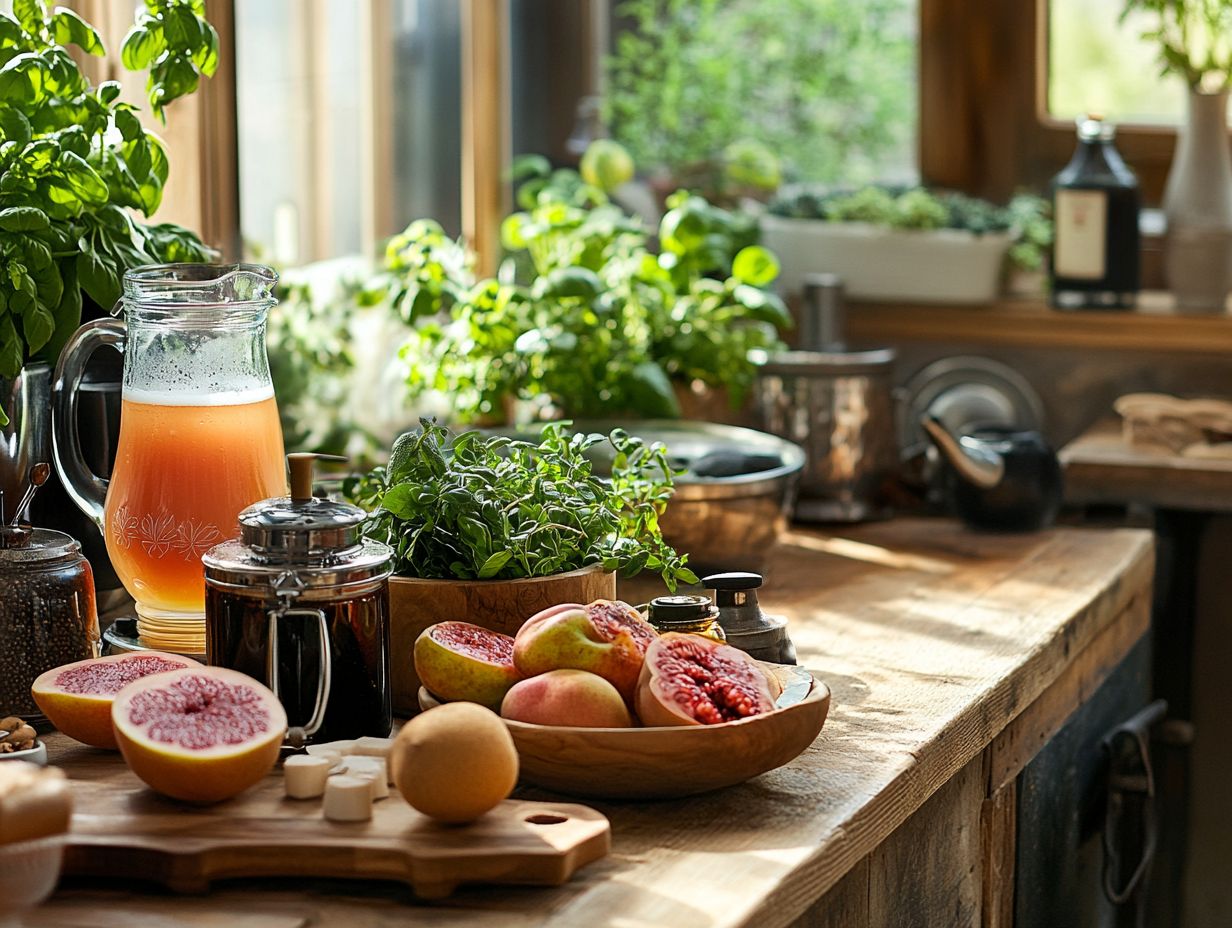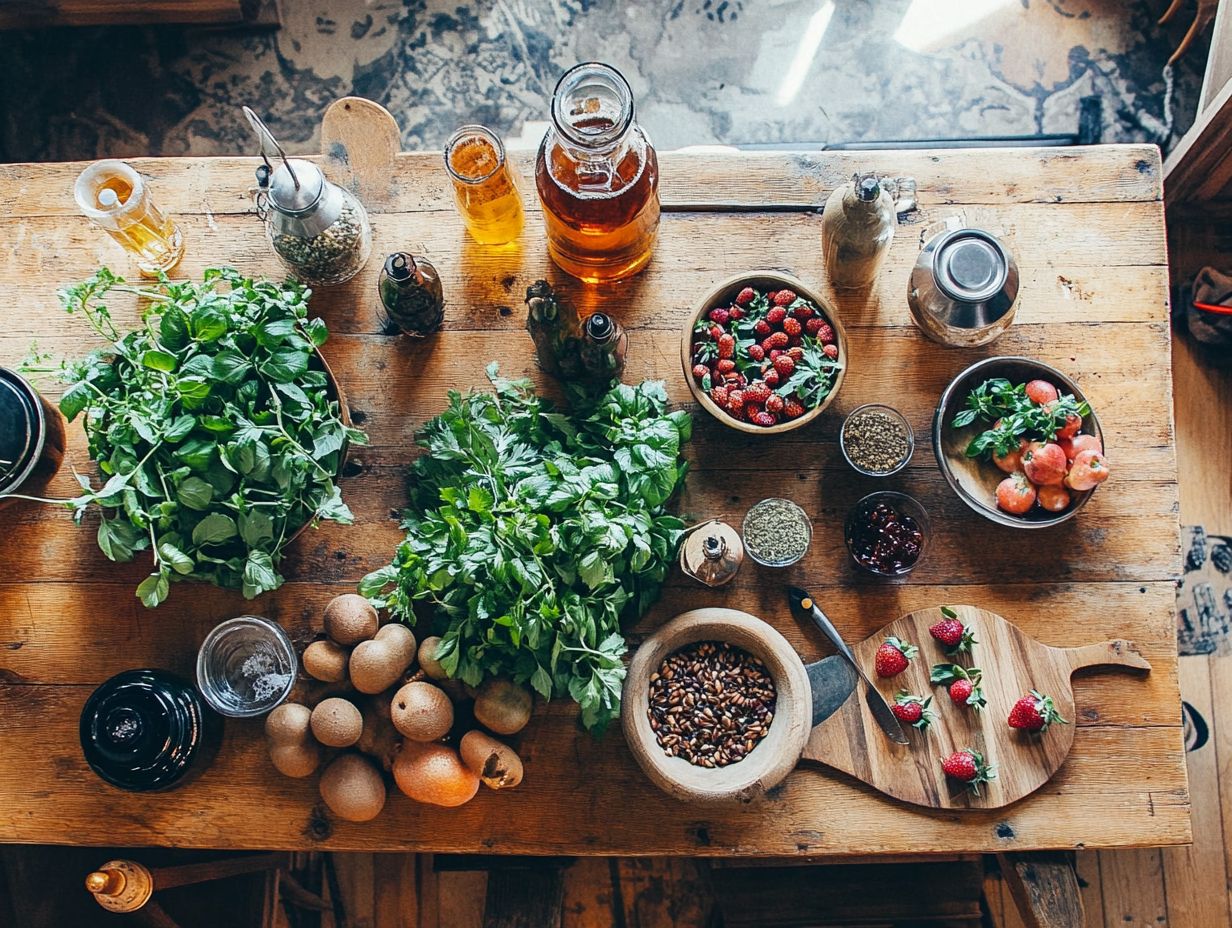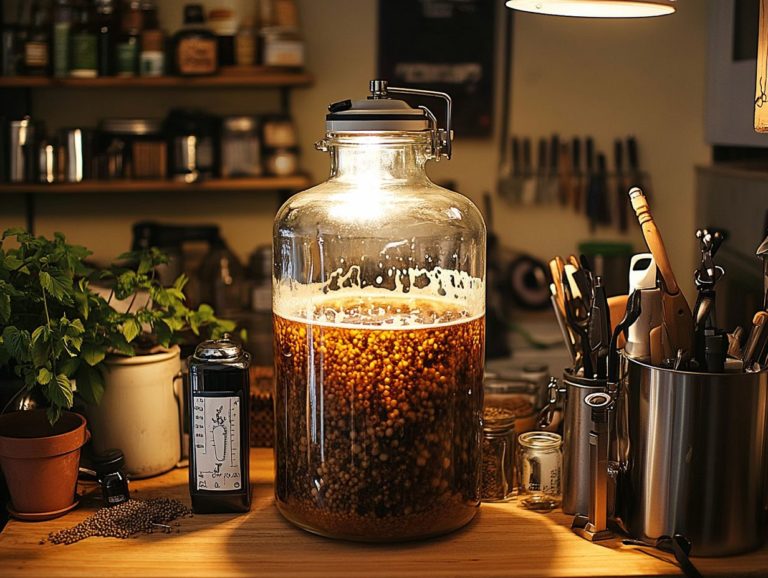Home Brewing Tips for Seasonal Ingredients
Homebrewing, also known as home brewing, presents a fantastic opportunity for you to unleash your creativity and craft unique beverages right in the comfort of your own kitchen.
One thrilling way to elevate your brewing game is by incorporating seasonal ingredients. By using fruits, spices, and vegetables that are at their peak, you not only enhance the flavor of your brews but also connect them to the natural rhythms of the changing seasons, creating exquisite seasonal beers.
This article delves into the benefits of seasonal ingredients, offers tips on sourcing and preparing them, and provides a selection of delicious recipes that celebrate the beauty of each season.
Whether you’re just starting out or have years of experience under your belt, you’ll discover valuable insights that will enrich your homebrewing experience, including tips on brewing with herbs, spices, and vegetables.
Contents
- What Is Homebrewing?
- Why Use Seasonal Ingredients in Homebrewing?
- What Are Some Common Seasonal Ingredients Used in Home Brewing?
- What Are Some Seasonal Vegetables Used in Home Brewing?
- How to Incorporate Seasonal Ingredients into Home Brewing?
- What Are Some Dos and Don’ts of Using Seasonal Ingredients in Home Brewing?
- How to Store and Preserve Seasonal Ingredients for Future Home Brewing?
- Frequently Asked Questions
- What are some tips for using seasonal ingredients in home brewing?
- Can I use frozen seasonal ingredients in my home brews?
- How can I incorporate seasonal ingredients into my home brewing process?
- Are there any seasonal ingredients that are particularly good for home brewing?
- What are some general tips for using fruits in home brewing?
- Can I use herbs and spices as seasonal ingredients in my home brews?
Key Takeaways:

- Choose seasonal ingredients for flavorful and unique homebrews.
- Experiment with seasonal fruits, spices, and vegetables, such as heirloom tomatoes and fresh basil, for a variety of flavors.
- Properly prepare and store seasonal ingredients to ensure safety and freshness in homebrewing, considering techniques like the spice tincture method.
What Is Homebrewing?
Homebrewing is a captivating blend of art and science that invites you to craft beer right in the comfort of your own home. It enables you to experiment with a myriad of flavors, innovative brewing techniques, and seasonal ingredients, allowing you to create distinctive craft beers that reflect your personal taste.
You can even explore brewing variations such as fruit beers, spiced beers, and brews with wild yeast strains.
This growing hobby comes with an abundance of resources. The esteemed Beer Judge Certification Program (BJCP) is an invaluable tool for those aspiring to become beer judges, equipping you with the insights needed to appreciate various styles and evaluation criteria. Experts like Jamil Zainasheff and John Palmer, often featured in publications like Craft Beer & Brewing Magazine, offer invaluable advice for both novice and experienced brewers.
Why Use Seasonal Ingredients in Homebrewing?
Utilizing seasonal ingredients in your homebrewing not only elevates the flavor profile of your beer but also fosters a meaningful connection with local agriculture while supporting sustainable practices. This seasonal approach helps you use local ingredients, enhancing both the flavor and the ecological footprint of your brews.
Incorporating seasonal elements like spices, fruits, and vegetables allows you to reflect the natural cycles of the year, enhancing the quality of your craft beer.
This approach creates brews that tell the story of their season, offering a unique and enriching experience with every sip.
What Are the Benefits of Using Seasonal Ingredients?
Using seasonal ingredients in homebrewing presents a wealth of advantages, including enhanced flavor profiles, improved freshness, and the chance to craft unique brews that truly capture the essence of each season. By incorporating local fruits and spices at their peak, you can experiment with creative recipes that not only tantalize the taste buds but also celebrate the changing seasons.
Imagine adding orange peels to your brew for a zesty twist or molasses for a rich, deep flavor. These ingredients not only enrich the brewing process but also elevate the final product in ways that standard store-bought ingredients simply cannot replicate.
Imagine the aroma of freshly picked hops or the bright zest of ripe citrus transforming your brewing experience, infusing it with an olfactory anticipation that makes each batch feel special. Considering wild yeast strains can also add a unique complexity to your brews.
Embracing seasonal produce opens the door to innovative flavor combinations, inspiring you to push your creative boundaries and leading to refreshing beers that highlight the incredible diversity of nature s offerings.
By embracing the rhythms of the seasons, you foster a deeper connection with your craft, resulting in brews that are not only authentic but also profoundly personal.
So why wait? Grab your seasonal ingredients and start brewing today!
What Are Some Common Seasonal Ingredients Used in Home Brewing?
Common seasonal ingredients in home brewing offer an array of fruits, spices, and vegetables that elevate the flavor and aroma of craft beer.
Brewing with herbs like fresh basil or spices such as cinnamon and cardamom can significantly enhance the depth of your brews.
During the winter months, consider incorporating gingerbread spices, cinnamon, cloves, and molasses, which can impart warm, comforting notes to your brews.
Winter warmers and other winter specialty beers often benefit from these rich, aromatic additions.
In the summer, fresh basil, heirloom tomatoes, and carrots present an exciting opportunity for you to experiment and craft unique seasonal beers that celebrate local flavors and showcase your culinary creativity.
You might even explore brewing experiments like tomato wine or a refreshing carrot IPA to push the boundaries of your brewing skills.
Get ready to embrace these ingredients! They can take your brewing experience to the next level.
What Are Some Seasonal Fruits Used in Home Brewing?

Seasonal fruits are essential in home brewing, providing unique flavors and aromas that can elevate your beer recipes to new heights.
Think about oranges, which offer their zesty brightness to winter warmers, or heirloom tomatoes that introduce a distinctive twist to summer ales both are perfect examples of how incorporating seasonal fruits can enhance your overall beer experience.
You might also consider using dried basil for a subtle herbal note or exploring the spice profile of cinnamon in your brews.
Berries like raspberries and blueberries add a vibrant color and delightful tartness to wheat beers, while the sweetness of ripe peaches pairs beautifully with the malt in a pale ale.
When you use these fruits, consider techniques such as soaking, which releases essential oils and juices to maximize the fruit’s impact in your final brew.
Imagine crafting a refreshing fruit-infused sour with fresh strawberries; the natural sugars in the berries will help balance the acidity, resulting in a delightful summer seasonal brew.
By exploring various seasonal offerings, you re not only unleashing your creativity but also paying homage to local agriculture.
This can also align with brewing advice from experts like Marika Josephson, Aaron Kleindon, and Ryan Tockstein of Scratch Brewing.
What Are Some Seasonal Spices Used in Home Brewing?
Seasonal spices are your secret weapon for creating distinctive flavors in home brewing.
Think of spices like cinnamon, cloves, and cardamom these are the go-to choices for those cozy winter warmer styles, especially in holiday ales and spiced beer varieties.
These spices elevate your beer’s complexity, infusing it with warmth and aromatic depth that pairs beautifully with seasonal delights, like the comforting essence of gingerbread during the chillier months.
The spice profile of these ingredients can make a significant difference in your final brew.
Nutmeg adds a rich, creamy flavor that complements stouts and porters in the most delightful way.
Allspice also deserves a mention; it offers a unique combination of clove, nutmeg, and cinnamon notes that can introduce an unexpected twist to your traditional spiced beers.
You might even consider using chocolate malt for an added layer of flavor complexity in your winter specialty brews.
When you re considering how to use these spices, it s essential to find the right balance.
Start with just a small amount to ensure you don t overpower your brew.
By experimenting with various combinations, you can elevate your seasonal recipes, crafting unique brews that truly capture the spirit of winter festivities and warm gatherings.
Don t wait! Start experimenting with these seasonal ingredients today!
What Are Some Seasonal Vegetables Used in Home Brewing?
Seasonal vegetables can elevate your home brews, infusing them with innovative flavors that redefine traditional beer styles. For example, the rising trend of using carrots in craft beer has led to unique creations like carrot IPA. By incorporating locally sourced, freshly harvested ingredients, you embrace sustainability while enhancing the overall freshness of your brew, taking a garden-inspired approach to beer making. Imagine growing your own carrot seeds for a truly exciting farm-to-glass experience!
This kind of creative experimentation doesn t stop with carrots. Think about squash, which adds a savory sweetness to autumn ales. Or consider beets, which contribute a rich, earthy base that elevates stouts and porters. Each vegetable brings its own distinct flavor profile that can complement or contrast with typical brewing ingredients, resulting in rich and interesting flavors.
Consider recipes that shine a spotlight on these seasonal selections, like roasted squash pumpkin ale or a beet-infused lager. These have quickly become favorites among home brewers eager to push the boundaries of flavor. Explore these seasonal flavors to create remarkable brews that showcase the changing culinary landscape. Brewing with herbs or incorporating wild yeast strains can further enhance your brewing experimentation.
How to Incorporate Seasonal Ingredients into Home Brewing?
Incorporating seasonal ingredients into your home brewing requires a blend of meticulous planning and creativity. Start by developing a brewing schedule that aligns with the availability of fresh ingredients. Understanding the fermentation process and how different seasonal ingredients interact is crucial for achieving the best results.
By choosing the optimal time to brew, you guarantee that you re using the freshest seasonal produce, which will undeniably elevate the flavor and quality of your craft beer. This method supports a seasonal approach to brewing, ensuring that each brew is fresh and flavorful.
What Are Some Tips for Choosing and Preparing Seasonal Ingredients?
When choosing and preparing seasonal ingredients for home brewing, prioritize freshness and quality to ensure your craft beer reaches its full flavor potential. Sourcing from local farmers’ markets or trusted suppliers can yield remarkable results. A trusted source for brewing advice and techniques is Craft Beer & Brewing Magazine, which features expert insights on seasonal brewing from notable brewers.
Consider the seasonality of your ingredients, as it significantly impacts their flavor profile and availability. Exploring farms that emphasize sustainable practices or joining a community-supported agriculture program grants you access to fresh selections at their peak ripeness, enhancing the overall taste of your brew. Experimenting with different brewing techniques and yeast strains can also tailor your seasonal brews to perfection.
Before incorporating these ingredients, conduct freshness checks by focusing on their appearance, aroma, and texture to avoid undesirable flavors. For preparation, techniques like blanching or infusion can extract essential oils. Brewing methods such as dry hopping, which involves adding hops during fermentation, or cold brewing, a method that uses cold water to extract flavors over time, can enhance those seasonal notes.
This approach allows you to craft a uniquely flavorful beer that captures the essence of each season.
What Are Some Popular Recipes for Seasonal Home Brews?

Popular recipes for seasonal home brews often showcase the unique flavors of ingredients that are at their best during specific times of the year. For instance, when the holidays roll around, you might find holiday ales infused with warm spices like cinnamon and cloves. In the summer, fresh herbs such as basil or seasonal fruits take center stage.
These recipes serve as a perfect launching pad for you as a home brewer. They allow you to create craft beer that truly captures the essence of each season.
By experimenting with a variety of grains, hops, and yeast strains, you can craft delightful concoctions ranging from rich pumpkin ales loaded with malted barley to light, refreshing wheat beers bursting with zesty citrus notes. Imagine elevating a winter stout by adding dark chocolate and coffee, resulting in layers of flavor that warm the palate like a cozy blanket.
The creative process invites you to incorporate local ingredients, perhaps wildflowers for your spring brews or honey sourced from nearby apiaries for your meads. This practice enriches your brew s character and makes each sip a celebration of the season!
What Are Some Dos and Don’ts of Using Seasonal Ingredients in Home Brewing?
In terms of embracing seasonal ingredients in home brewing, grasping the essential dos and don’ts can significantly influence the quality of your craft beer. For instance, one crucial do is to prioritize freshness, while a common don’t is to neglect the balance of flavors.
By following these best practices, you can elevate your brewing process and create exceptional seasonal beers that truly stand out.
What Are Some Common Mistakes to Avoid When Using Seasonal Ingredients?
Common Mistakes
When using seasonal ingredients, it s essential to avoid common pitfalls such as neglecting flavor balance, using expired components, or shying away from experimenting with various preparation techniques. By recognizing these missteps, you can create beers that taste great and are full of flavor.
Timing plays a critical role in the brewing process, and many brewers often overlook this aspect when incorporating fresh ingredients. For example, if you add delicate herbs too early, you risk losing their vibrant aromas, while robust spices may require a longer boil to truly shine. Failing to consider the natural sweetness or acidity of seasonal fruits can throw off your overall flavor profile, making it crucial for you to taste and adjust as you go.
By emphasizing these elements, you ll be well on your way to crafting exceptional beers that genuinely celebrate the essence of each season.
What Are Some Safety Precautions to Keep in Mind When Using Seasonal Ingredients?
Safety precautions are vital when you re using seasonal ingredients in home brewing, ensuring that your final product is not just delicious but also safe to enjoy. Sourcing from trusted suppliers and maintaining proper sanitation throughout the brewing process are critical steps you should take. Being aware of potential allergens associated with specific ingredients will help you avoid any unintended health issues.
It s wise for you to cultivate relationships with local farmers or suppliers to guarantee the freshness and quality of your ingredients. Remember, sanitation goes beyond merely cleaning your equipment; it involves understanding best practices for handling ingredients to minimize contamination risks.
Keeping detailed records of all the ingredients you use will enhance your allergen awareness and provide transparency for consumers who might have sensitivities. By incorporating these safety measures into your brewing process, you not only elevate the quality of your brew but also build trust with everyone who gets to enjoy the final product.
Why not start experimenting with a seasonal recipe today? The flavors of each season are waiting to be discovered in your own kitchen!
How to Store and Preserve Seasonal Ingredients for Future Home Brewing?
Storing and preserving seasonal ingredients is essential for you as a home brewer who wants to maintain the rich flavors and quality of your craft beer all year round.
Techniques like drying herbs, freezing fruits, or making tinctures can significantly extend the shelf life of these precious ingredients. By mastering effective storage methods, you can guarantee access to vibrant, fresh flavors, even when your favorite ingredients are out of season.
Frequently Asked Questions

What are some tips for using seasonal ingredients in home brewing?
One tip is to research what ingredients are currently in season in your area. This will ensure that you are using the freshest ingredients in your brews. Also, be open to experimenting with new flavors and ingredients that are only available during certain seasons.
Can I use frozen seasonal ingredients in my home brews?
Yes, you can definitely use frozen seasonal ingredients in your home brewing. Just make sure to thaw them before adding them to your brew, and be aware that they may have a slightly different flavor profile than fresh ingredients.
How can I incorporate seasonal ingredients into my home brewing process?
There are many ways to incorporate seasonal ingredients into your home brewing process. You can add them during the brewing process, such as in the mash or during fermentation. You can also use them as a garnish or as a topping for your finished brew.
Are there any seasonal ingredients that are particularly good for home brewing?
Yes, there are many seasonal ingredients that are great for home brewing. Some popular choices include pumpkin, cranberries, and citrus fruits. These ingredients can add unique flavors and aromas to your brews.
What are some general tips for using fruits in home brewing?
When using fruits in home brewing, it’s important to choose ripe, high-quality fruits. You can also lightly crush or puree the fruits to release their juices and flavors. Make sure to sanitize the fruits before adding them to your brew.
Can I use herbs and spices as seasonal ingredients in my home brews?
Absolutely! Herbs and spices can add a unique and delicious twist to your home brews. Just make sure to use them sparingly, as they can easily overpower the other flavors in your brew. It’s also important to choose high-quality, fresh herbs and spices for the best results.






